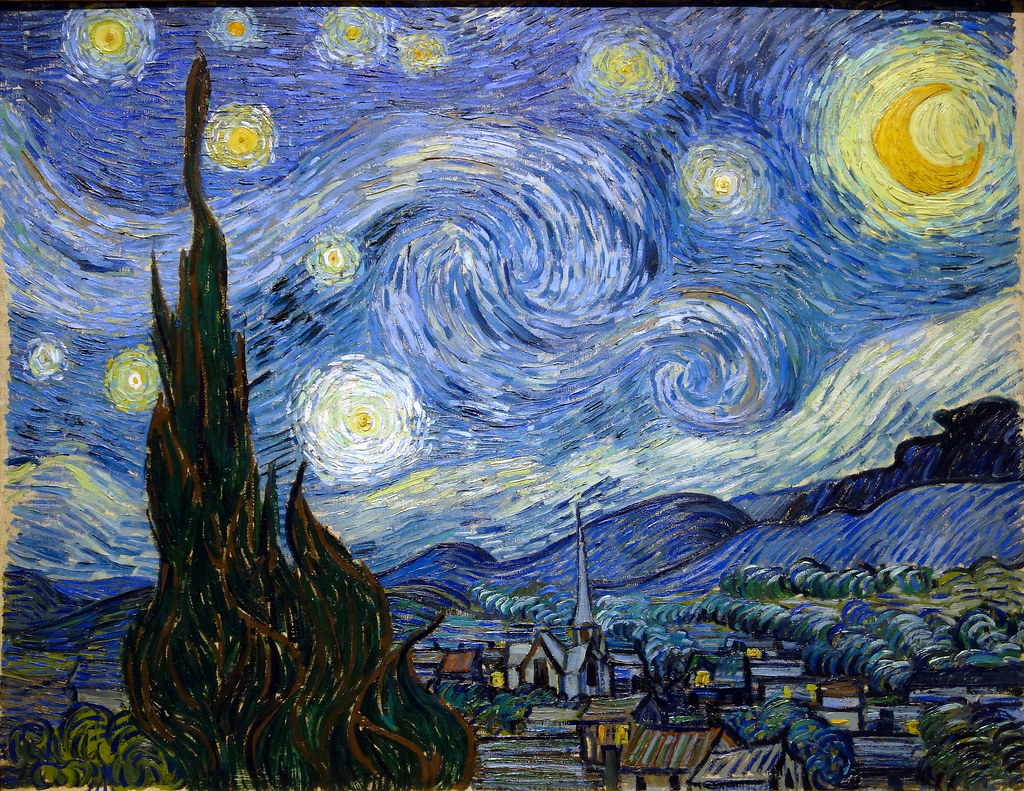4.2: Painting
- Page ID
- 156868
Overview
- Painting
is the application of pigments to a support surface that establishes an image, design or decoration. - In art the term “painting” describes both the act and the result.
- Three of the most recognizable images in Western art history are paintings: Leonardo da Vinci’s Mona Lisa, Edvard Munch’s The Scream and Vincent van Gogh’s The Starry Night. These three art works are examples of how painting can go beyond a simple mimetic function, that is, to only imitate what is seen. The power in great painting is that it transcends perceptions to reflect emotional, psychological, even spiritual levels of the human condition.
- Painting media are extremely versatile because they can be applied to many different surfaces (called supports) including paper, wood, canvas, plaster, clay, lacquer and concrete.
- Because paint is usually applied in a liquid or semi-liquid state it has the ability to soak into the porous support material, which can, over time, weaken and damage the it. To prevent this a support is usually first covered with a ground, a mixture of binder and chalk that, when dry, creates a non-porous layer between the support and the painted surface. A typical ground is gesso.
Media
There are six major painting media, each with specific individual characteristics:
- Encaustic
- Tempera
- Fresco
- Oil
- Acrylic
- Watercolor
- Mixed Media
All of them use the following three basic ingredients:
- Pigment
- Binder
- Solvent
Pigments are granular solids incorporated into the paint to contribute color. The binder, commonly referred to as the vehicle, is the actual film-forming component of paint. The binder holds the pigment in solution until it’s ready to be dispersed onto the surface. The solvent controls the flow and application of the paint. It’s mixed into the paint, usually with a brush, to dilute it to the proper viscosity, or thickness, before it’s applied to the surface. Once the solvent has evaporated from the surface the remaining paint is fixed there. Solvents range from water to oil-based products like linseed oil and mineral spirits.
Let’s look at each of the six main painting media:
1.Encaustic
- Encaustic uses melted beeswax as the binder and must be applied to rigid supports like wood with heated brushes. The advantage of encaustic is that it remains fresh and vibrant over centuries. Encaustic paintings from ancient Egypt dating to the period of Roman occupation (late first century BCE-third century CE) are as brilliantly colored as when they were first painted. (Figure 2.10)
- The mixture is then brushed or spread across a support surface.
- Reheating allows for longer manipulation of the paint.
- Encaustic dates back to the first century C.E. and was used extensively in funerary mummy portraits from Fayum in Egypt.
- The characteristics of encaustic painting include strong, resonant colors and extremely durable paintings.
- Portrait of a boy, c. 100–150 CE would have been used as a funerary adornment.
- Artist created a naturalistic likeness of the deceased

2. Tempera
- Tempera paint combines pigment with an egg yolk binder, then thinned and released with water.
- Like encaustic, tempera has been used for thousands of years. It dries quickly to a durable matte finish.
- Tempera paintings are traditionally applied in successive thin layers, called glazes, painstakingly built up using networks of cross-hatched lines. Because of this technique tempera paintings are known for their detail.
- In early Christianity, tempera was used extensively to paint images of religious icons.
- The pre-Renaissance Italian artist Duccio (c. 1255 – 1318), one of the most influential artists of the time, used tempera paint in the creation of The Crevole Madonna (above). You can see the sharpness of line and shape in this well-preserved work, and the detail he renders in the face and skin tones of the Madonna (see the detail below).
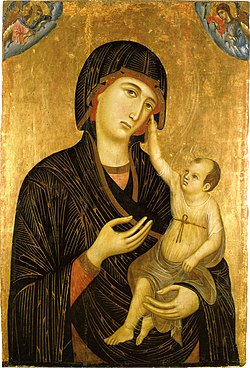 .
. .jpeg?revision=1&size=bestfit&width=445&height=550)
Duccio, The Crevole Madonna, c. 1280. Tempera on board. Museo dell’Opera del Duomo, Siena, Italy. Image is in the public domain
3.Fresco
- Fresco painting is used exclusively on plaster walls and ceilings.
- The medium of fresco has been used for thousands of years, but is most associated with its use in Christian images during the Renaissance period in Europe.
- There are two forms of fresco: Buon or “wet,”and secco, meaning “dry.”
- Buon fresco technique consists of painting in pigment mixed with water on a thin layer of wet, fresh lime mortar or plaster. The pigment is applied to and absorbed by the wet plaster; after a number of hours, the plaster dries and reacts with the air: it is this chemical reaction that fixes the pigment particles in the plaster. Because of the chemical makeup of the plaster, a binder is not required. Buon fresco is more stable because the pigment becomes part of the wall itself.
- Domenico di Michelino’s Dante and the Divine Comedy from 1465 (below) is a superb example of buon fresco.
- The colors and details are preserved in the dried plaster wall.
- Michelino shows the Italian author and poet Dante Aleghieri standing with a copy of the Divine Comedy open in his left hand, gesturing to the illustration of the story depicted around him.
- The artist shows us four different realms associated with the narrative: the mortal realm on the right depicting Florence, Italy; the heavenly realm indicated by the stepped mountain at the left center – you can see an angel greeting the saved souls as they enter from the base of the mountain; the realm of the damned to the left – with Satan surrounded by flames greeting them at the bottom of the painting; and the realm of the cosmos arching over the entire scene.
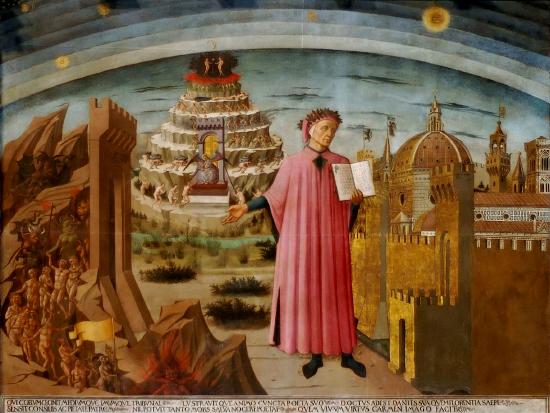
Domenico di Michelino, Dante’s Divine Comedy, 1465, buon fresco, the Duomo, Florence, Italy. This image is in the public domain
- Secco fresco refers to painting an image on the surface of a dry plaster wall. This medium requires a binder since the pigment is not mixed into the wet plaster. Egg tempera is the most common binder used for this purpose. It was common to use secco fresco over buon fresco murals in order to repair damage or make changes to the original.
- Leonardo Da Vinci’s painting of The Last Supper (below) was done using secco fresco.
Leonardo Da Vinci, The Last Supper, 1495–98, dry fresco on plaster. Church of Santa Maria delle Grazie, Milan. This image is in the public domain
4.Oil
- Oil paint is the most versatile of all the painting media.
- It uses pigment mixed with a binder of linseed oil. Linseed oil can also be used as the vehicle, along with mineral spirits or turpentine.
- Oil painting was thought to have developed in Europe during the fifteenth century, but recent research on murals found in Afghanistan caves show oil based paints were used there as early as the seventh century.
- Some of the qualities of oil paint include a wide range of pigment choices, its ability to be thinned down and applied in almost transparent glazes as well as used straight from the tube (without the use of a vehicle), built up in thick layers called impasto. You can see it below in Van Gogh's paintings.
- One drawback to the use of impasto is that over time the body of the paint can split, leaving networks of cracks along the thickest parts of the painting. Because oil paint dries slower than other media, it can be blended on the support surface with meticulous detail. This extended working time also allows for adjustments and changes to be made without having to scrape off sections of dried paint.
Vincent van Gogh, Starry Night, oil on canvas, 1889. "Van Gogh, Starry Night" by profzucker is licensed under CC BY-NC-SA 2.0.
- In Jan Brueghel the Elder’s still life oil painting you can see many of the qualities mentioned above.
- The richness of the paint itself is evident in both the resonant lights and inky dark colors of the work.
- The working of the paint allows for many different effects to be created, from the softness of the flower petals to the reflection on the vase and the many visual textures in between.
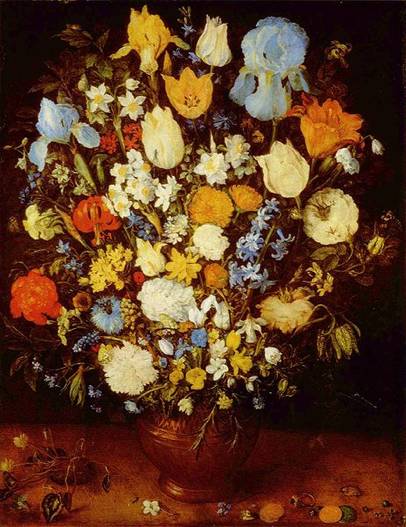
Jan Brueghel the Elder, Flowers in a Vase, 1599. Oil on wood. Kunsthistorisches Museum, Wien, Germany. Used under GNU Documentation Licensing
5.Acrylic
- Acrylic paint was developed in the 1950’s and became an alternative to oils.
- Pigment is suspended in an acrylic polymer emulsion binder and uses water as the vehicle. The acrylic polymer has characteristics like rubber or plastic.
- Acrylic paints offer the body, color resonance, and durability of oils without the expense, mess, and toxicity issues of using heavy solvents to mix them. One major difference is the relatively fast drying time of acrylics.
- They are water-soluble, but once dry become impervious to water or other solvents. Moreover, acrylic paints adhere to many different surfaces and are extremely durable. Acrylic impastos will not crack or yellow over time.
- Julie Mehretu uses acrylic paint so she can alternate layers as she works
- She adds drawings between layers during her process.
- Using acrylic allows her to integrate other media in to her work.
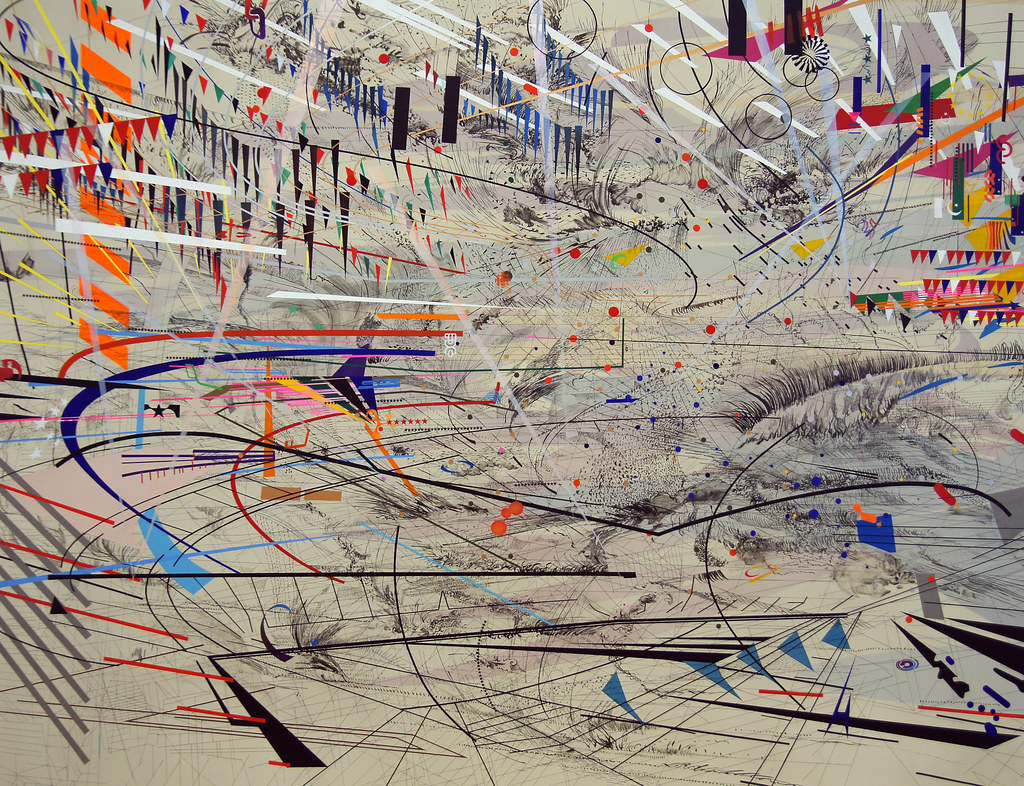
Julie Mehretu, Excerpt (Suprematist Evasion), 2003. Ink and acrylic on canvas, 32 x 54”. "2011-08-27 San Francisco 013 MOMA, Julie Mehretu - Stadia 1" by Allie_Caulfield is licensed under CC BY 2.0.
6. Watercolor
- Watercolor is the most sensitive of the painting media.
- It reacts to the lightest touch of the artist and can become an over-worked mess in a moment.
- There are two kinds of watercolor media: transparent and opaque. Transparent watercolor operates in a reverse relationship to the other painting media. It is traditionally applied to a paper support, and relies on the whiteness of the paper to reflect light back through the applied color (see below), whereas opaque paints (including opaque watercolors) reflect light off the skin of the paint itself. Watercolor consists of pigment and a binder of gum arabic, a water-soluble compound made from the sap of the acacia tree. It dissolves easily in water.
- John Singer Sargent worked en plein air, or outdoors, using the landscape as subject matter. He portrays the brilliance of outdoor light as an integral part in this work.
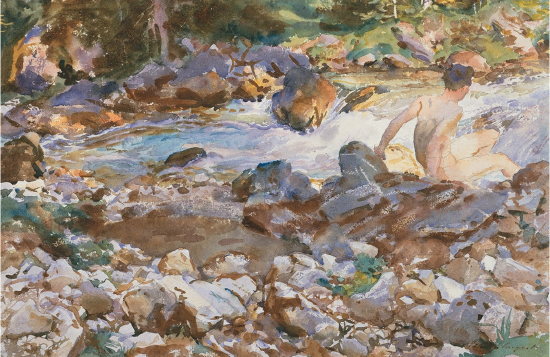
John Singer Sargent, Mountain Stream, c. 1912–14. Watercolor and graphite on off-white wove paper, 13¾ × 21“. Metropolitan Museum of Art, New York
- Opaque watercolor, also called gouache, differs from transparent watercolor in that the particles are larger, the ratio of pigment to water is much higher, and an additional, inert, white pigment such as chalk is also present. Because of this, gouache paint gives stronger color than transparent watercolor, although it tends to dry to a slightly lighter tone than when it is applied. Gouache paint doesn’t hold up well as impasto, tending to crack and fall away from the surface. It holds up well in thinner applications and often is used to cover large areas with color. Like transparent watercolor, dried gouache paint will become soluble again in water.
- Jacob Lawrence’s paintings use gouache to set the design of the composition.
- Large areas of color – including the complements blue and orange, dominate the figurative shapes in the foreground.
- The characteristics of gouache make it difficult to be used in areas of detail.
- Through his placement of the six figures, Lawrence creates a visual rhythm in the composition that includes bridges, breaks, changes, and variations—all part of the translation of his love of jazz into a visual medium. 1
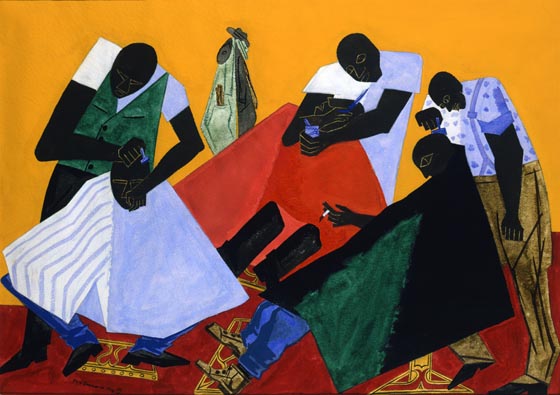
Jacob Lawrence (American, 1917–2000), Barber Shop. Gouache on paper, 1946. 21 1/8 x 29 3/8 in. Purchased with funds from the Libbey Endowment, Gift of Edward Drummond Libbey, 1975.15. Gallery 6 The Toledo Museum of Art
7.Mixed Media
- Traditional boundaries between art media have been blurred as artists explore new ways to express themselves. Mixed media and collage are popular ways of integrating imagery. 3
- Robert Rauschenberg in his incorporates everyday life items—including anything that caught his imagination, from rubber tires to light bulbs—into his wide-ranging work. In many of his works, like Bed, he merged elements of postwar abstract painting with found objects.
- Bed is one of Rauschenberg’s first combines, a term he coined to describe the works resulting from his technique of attaching found objects to a traditional canvas support. In this work, however, there is no canvas. The artist took a well-worn pillow, sheet, and quilt, scribbled on them with pencil, splashed them with paint in a style similar to Jackson Pollock’s action paintings, and hung the entire ensemble on the wall. 2
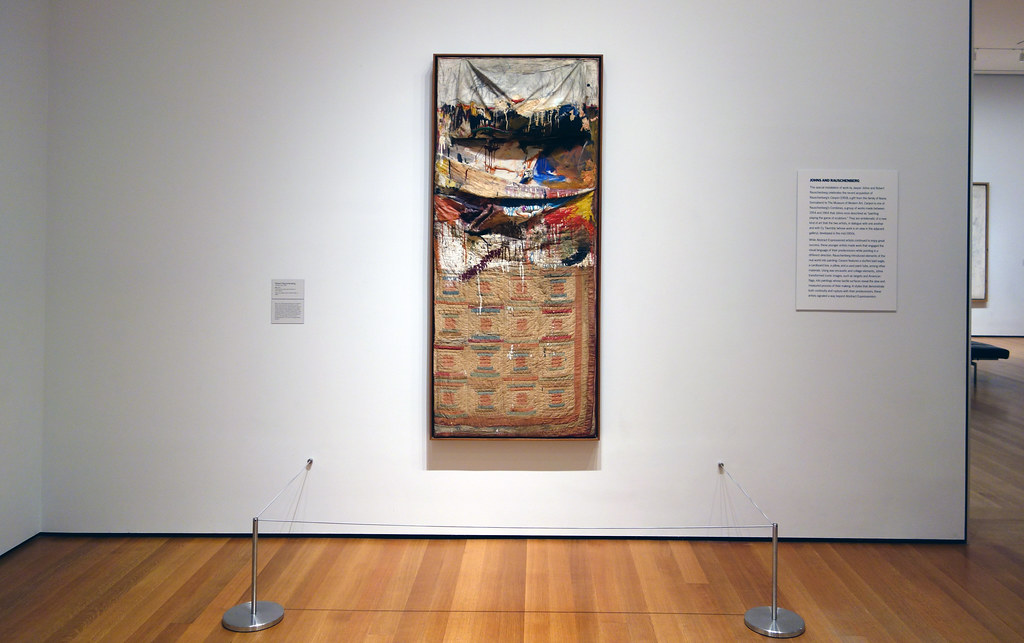
Robert Rauschenberg, Bed, 1955. Oil and pencil on pillow, quilt, and sheet on wood supports, 75¼ × 31½ × 8”. MoMA, New York. "Robert Rauschenberg, Bed (on wall)" by profzucker is licensed under CC BY-NC-SA 2.0.
Sources
- Art Minute: Jacob Lawrence, 'Barber Shop'. https://www.toledomuseum.org/about/n...ce-barber-shop Feb. 27
- Moma Learning. www.moma.org/learn/moma_lear...berg-bed-1955/
- Debra J. DeWitte, Ralph M. Larmann, and M. Kathryn Shields. Gateways to Art: Understanding the Visual Arts, Third Edition.
- Pamela Sachant, Peggy Blood, Jeffery LeMieux, & Rita Tekippe University System of Georgia via GALILEO Open Learning Materials


